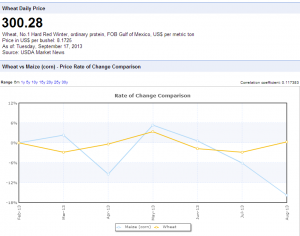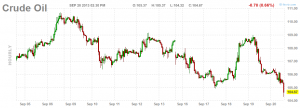Trade and portfolio summary
This week my portfolio value finally changed from deficit to profit, gaining a 2.48% return up to Friday morning. My limit order of selling wheat came into effect, which contributed a lot to my return. And I also shorted 2 units of wheat at the price of 6.735, forecasting a tendency of dropping in the near few days. (Though the fact is that there was a continuous rise in the price of wheat.) I’ve set 3 limit orders this week, but none of them were filled because of my wrong judgement of the market.
Why make these decisions and what I’ve learnt?
1.Something about U.S. crude oil
U.S. crude oil ended lower for a fourth straight Tuesday, as the geopolitical tensions in the Middle East easing. The gradually thawing relations between Iran and U.S. directly rendered the decrease of oil demand and price. Thus, I regarded it as a sign of declining in corn’s price and bought corns at the price of 4.5675 which was a quite low price. I was prepared to make the investment in a long run. Plus, the US crude oil report released by EIA (the U.S. Energy Information Administration) this Wednesday morning sent the price tumbling for its increased inventory. I guessed there would be fluctuations this week in the corn’s price.
2.Why wheat price soared at the end of the week
The higher price largely resulted from the strong export demand and problems with Argentina’s winter crop. As Argentina is a major world supplier of wheat, corn and soybeans, the concerns of cold snap may have some influences on the fluctuation in wheat price. The kind of unpredictable factor made the commodity market prices volatile and hard to control. Tomas Parenti, the weather expert at the Rossario grains exchange, said via the media that “The leaves on some of the more susceptible varieties (of wheat) may have suffered from the cold, but the plants themselves can recuperate.” Thus, the effect may not last for a long time. I still stand the point that wheat price is the most stable one among the three crops. When I trade corns and soybeans, I always tend to be more cautious, for there’s too many drivers that can influence the price, ranging from the politics to the weather, from the oil price to the related rumors.
Conclusion & strategy for next week
This week the limit order set last week helped me a lot in trading timely at the ideal price, though I failed to win more because of the unpredictable driver. I’m inclined to be a conservative trader making options on ground of data and facts rather than a gambler hoping for a fat profit without doing anything.
Next week, I will start focusing on the Federal Reserve’s next move on its monetary policy at its meeting in October, and continue to observe the influences from the crude oil price.
Good luck~
Vanilla



